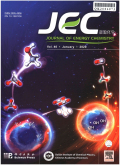- 钛学术文献服务平台 \
- 学术期刊 \
- 工业技术期刊 \
- 石油与天然气工业期刊 \
- 能源化学期刊 \
Utilizing 3,4-ethylenedioxythiophene (EDOT)-bridged non-fullerene acceptors for efficient organic solar cells
Utilizing 3,4-ethylenedioxythiophene (EDOT)-bridged non-fullerene acceptors for efficient organic solar cells
基本信息来源于合作网站,原文需代理用户跳转至来源网站获取
摘要:
A rational design of efficient low-band-gap non-fullerene acceptors (NFAs) for high-performance organic solar cells (OSCs) remains challenging;the main constraint being the decrease in the energy level of the lowest unoccupied molecular orbitals (LUMOs) as the bandgap of A-D-A-type NFAs decrease.Therefore,the short current density (Jsc) and open-circuit voltage (Voc) result in a trade-off relationship,making it difficult to obtain efficient OSCs.Herein,three NFAs (IFL-ED-4F,IDT-ED-4F,and IDTT-ED-2F) were synthe-sized to address the above-mentioned issue by introducing 3,4-ethylenedioxythiophene (EDOT) as a n-bridge.These NFAs exhibit relatively low bandgaps (1.67,1.42,and 1.49 eV,respectively) and upshifted LUMO levels (-3.88,-3.84,and-3.81 eV,respectively) compared with most reported low-band-gap NFAs.Consequently,the photovoltaic devices based on IDT-ED-4F blended with a PBDB-T donor polymer showed the best power conversion efficiency (PCE) of 10.4% with a high Jsc of 22.1 mA cm-2 and Voc of 0.884 V among the examined NFAs.In contrast,IDTIT-ED-4F,which was designed with an asymmetric structure of the D-π-A type,showed the lowest efficiency of 1.5% owing to the poor morphology and charge transport properties of the binary blend.However,when this was introduced as the third compo-nent of the PM6:BTP-BO-4Cl,complementary absorption and cascade energy-level alignment between the two substances could be achieved.Surprisingly,the IDTT-ED-4F-based ternary blend device not only improved the Jsc and Voo but also achieved a PCE of 15.2%,which is approximately 5.3% higher than that of the reference device with a minimized energy loss of 0.488 eV.In addition,the universality of IDTT-ED-2F as a third component was effectively demonstrated in other photoactive systems,specifically,PM6:BTP-eC9 and PTB7-Th:IEICO-4F.This work facilitates a better understanding of the structure-property rela-tionship for utilizing efficient EDOT-bridged NFAs in high-performance OSC applications.

推荐文章
1,4-二乙氧基苯与3,4-亚乙基二氧噻吩的电化学共聚
电化学共聚
1,4-二乙氧基苯
3,4-亚乙基二氧噻吩
电化学性能
表面形貌
光致发光
3,4-二硝基吡唑的合成
二硝基吡唑
TNT替代物
硝化
合成
3,4-二硝基呋咱的合成
二氨基呋咱
二硝基呋咱
氧化
合成
内容分析
关键词云
关键词热度
相关文献总数
(/次)
(/年)
引文网络
引文网络
二级参考文献 (0)
共引文献 (0)
参考文献 (0)
节点文献
引证文献 (0)
同被引文献 (0)
二级引证文献 (0)
2022(0)
- 参考文献(0)
- 二级参考文献(0)
- 引证文献(0)
- 二级引证文献(0)
引文网络交叉学科
相关学者/机构
期刊影响力
能源化学
主办单位:
中国科学院大连化学物理研究所
中国科学院成都有机化学研究所
出版周期:
双月刊
ISSN:
2095-4956
CN:
10-1287/O6
开本:
出版地:
大连市中山路457号
邮发代号:
创刊时间:
语种:
eng
出版文献量(篇)
2804
总下载数(次)
0
总被引数(次)
7996
期刊文献
相关文献
推荐文献
- 期刊分类
- 期刊(年)
- 期刊(期)
- 期刊推荐
一般工业技术
交通运输
军事科技
冶金工业
动力工程
化学工业
原子能技术
大学学报
建筑科学
无线电电子学与电信技术
机械与仪表工业
水利工程
环境科学与安全科学
电工技术
石油与天然气工业
矿业工程
自动化技术与计算机技术
航空航天
轻工业与手工业
金属学与金属工艺
能源化学2022
能源化学2021
能源化学2020
能源化学2019
能源化学2018
能源化学2017
能源化学2016
能源化学2015
能源化学2014
能源化学2013
能源化学2012
能源化学2011
能源化学2010
能源化学2009
能源化学2008
能源化学2007
能源化学2006
能源化学2005
能源化学2004
能源化学2003
能源化学2002
能源化学2001

 免费查重
免费查重










